Mansions of New England


Newport, Rhode Island
Visiting the famous Gilded Age mansions of Newport, Rhode Island offers a unique experience through 250 years of American history, architecture, art, and landscape design. There are 11 fabulous homes on the Newport mansions list, once referred to as "summer cottages". You can easily drive around town and visit them all individually, taking tours of each. Some are given by tour guides, while others are audio tours designed to let you move about the mansions at your leisure. You can also choose from different Newport, RI mansion tours that take you around to the various homes, often by an old-fashioned trolley.
Newport's mansions are beautiful and many of their occupants and owners were among the most famous and well-to-do names in American history. Visitors come to Newport to step back in time to these elegant mansions of the past, walking in the footsteps of industrial magnates and oil barons and reveling in the luxury that was enjoyed by those in the upper echelons of society.
Today there are 11 sites that are open to the public. They include The Breakers, perhaps the most well-known of the mansion, and certainly the most over-the-top; The Elms, built for Edward Julius Berwind, a coal baron; Rosecliff, modeled after the Grand Trianon of Versailles by architect Stanford White; Chateau-sur-Mer, the most lavish until the Vanderbilts constructed their lavish mansions; Kingscote, distinctive as one of the first of Newport's summer cottages to be constructed; Isaac Bell House, this was built for the Cotton broker and investor Isaac Bell, Jr.; Hunter House, nearly 100 years older than the Gilded Age mansions, it was built in 1748 for Colonial Deputy Governor Jonathan Nichols Jr.; Chepstow, another beautiful one-time summer home, built in 1860; Rough Point, designed by architectural firm Peabody & Stearns for Frederick William Vanderbilt and constructed in 1892; and Belcourt, built for Oliver Belmont, a wealthy bachelor, this mansion has a Gothic, almost churchy vibe.
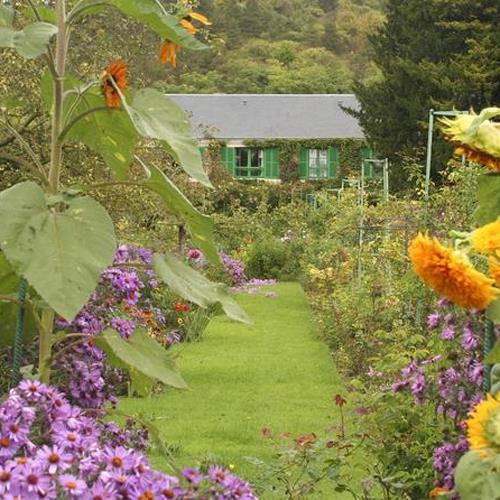
Falmouth, Massachusetts (Highfield Hall & Gardents)
Falmouth, MA, located on Cape Cod, is full of charming sites and attractions. Settlers first arrived in Falmouth in the 1600s and named the location after a British town. In the late 1800s, after railroad service was established between Boston and Cape Cod, James Madison Beebe bought over 700 acres and built Highfield Hall, which is now a museum, and much of the land is preserved as Beebe Woods.
Highfield Hall and Gardens marked a significant step in the development of the Massachusetts community. Built in 1878 by the heirs to a mercantile fortune created by James Beebe, one of Boston's merchant princes, Highfield Hall was one of the early summer retreats to grace Cape Cod and is one of the few remaining examples of Stick-style Queen Anne architecture in the Northeast. Along with its adjoining mansion, Tanglewood, which was demolished in 1977, Highfield Hall was originally surrounded by park-like gardens, carriage trails, and almost 700 acres of woodlands. The Beebe families entertained in grand style at Tanglewood and Highfield Hall and embraced a genteel and formal lifestyle supported by a huge team of servants. When the last Beebe family died in 1932, leaving no heirs, the state was sold with each subsequent owner having their own dream for the property. However, in 1994, Highfield was faced with demolition. This lead a group of citizens to save the mansion, and in 2001, a successful restoration project was possible through the donations of these citizens' efforts. In 2005, the construction phase began with a new foundation and new electrical and plumbing. Restoration continued through 2012. Since opening to the public, Highfield has welcomed hundreds of thousands of visitors who now enjoy a view of the Gilded Age mansion as it appeared in the 1880s. The mansion has a museum and cultural center; check the website for events and activities (art exhibitions, concerts on the lawn, etc.). Beeb Woods, the beautiful surrounding gardens and trails, is open to visitors year-round.
In addition to Highfield Hall, the town of Falmouth has seven historic districts, including four on the National Register of Historic Places: Falmouth Village Green, North Falmouth Village, Waquoit, and West Falmouth Village.
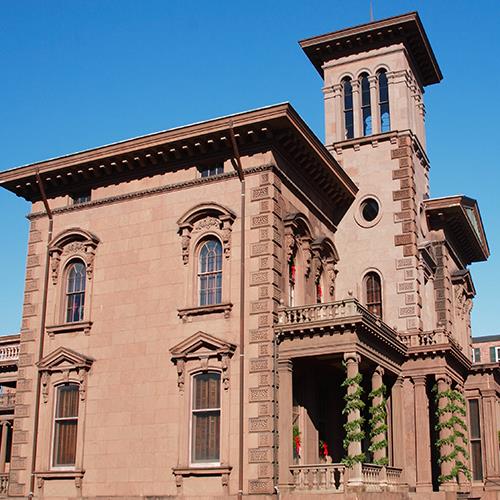
Portland, Maine (Victoria Mansion)
Built by hotelier Ruggles Sylvester Morse and his wife Olive between 1858 and 1860, the Maine natives used the beautiful Victoria mansion as an escape from oppressive summers in their adopted home of New Orleans. No expense was spared or luxury excluded on this opulence of a Victoria Mansion.
After the mansion was damaged during a hurricane in 1938, the house was scheduled for demolition to make way for a gas station. A Maine resident quickly bought the home and turned it into a museum in honor of Queen Victoria.
What makes this Victoria Mansion so important in the eyes of historians is that it's seen as an exemplary illustration of pre-Civil War grandeur. The exterior of the house was modeled after an Italian villa and features an ornate square tower, numerous balconies and piazzas. The interior is even more amazing. Ninety percent of the original interiors are still intact with carved wood paneled walls, gas light fixtures, cherub-clad crown molds, and ornate draperies and carpeting throughout. Designed by Gustave Herter of Herter Brothers, one of the most popular design firms of the day, it was the only work of his kind in the United States that remains intact.
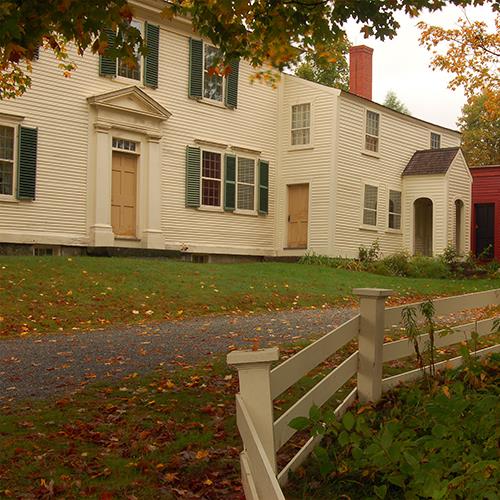

Concord, New Hampshire (Pierce Manse)
The historic house museum, Pierce Manse, was the home of the 14th President of the United States, Franklin Pierce, who lived there from 1842 to 1848, not long before his Presidency.
Franklin Pierce and his wife Jane Pierce moved here after she persuaded him to resign his seat in the United State Senate and leave Washington, DC. Pierce resumed his law practice and also served as district attorney and chairman of the Democratic Party.
The home is open all year round to the public and guided tours are available. When you step into the house you can see the many objects from President Pierce's day-to-day life and learn how things were in the middle of the 19th Century. The property itself was nearly destroyed in 1971 but a group of volunteers saved the house and made it into the museum it is today.
In addition to the Pierce Manse, the city of Concord, NH is also home to a wealth of other historic properties that can be visited today as museums. Other homes to include in your visit are the Mary Baker Eddy Historic House, the Upham-Walker House, and the Bridges House.
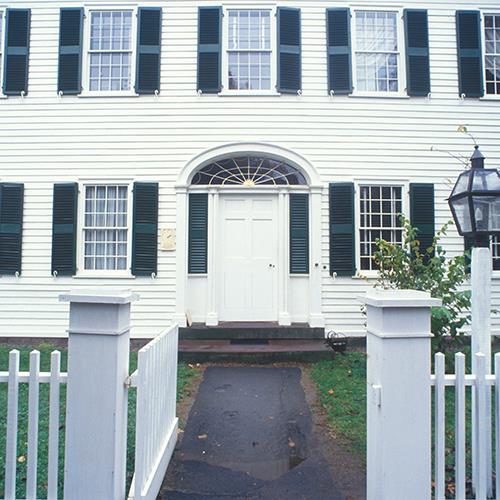
Marblehead, Massachusetts (Jeremiah Lee Mansion)
Built in 1768 for a wealthy "merchant prince", the Lee Mansion is a fabulous example of pre-Revolutionary Georgian architecture. Lee was the wealthiest merchant in Massachusetts according to tax records from 1771, and he might have been America's largest pre-revolutionary shipowner with a full share in over twenty vessels. The home still features original finely-crafted and detailed woodwork, hand-painted wallpaper from the 18th century, and a grand entry hall and staircase paneled with rich mahogany.
Preserved in a nearly original state, the house stands as a tribute to both Colonial America's strong ties to England and its independent commercial success. The home is open for visits where friendly guides welcome questions and are well-versed in the history of the home. The gardens are open to the public. Across the street at 170 Washington Sr., the J.O.J. Frost Gallery and Carolyn Lynch Education Center feature paintings, wooden models, and carvings by the noted folk artist J.O.J. Front, a Marblehead native. The Museum also operates the Civil War & B.A.R. Museum, located within the Old Town House, open to the public as well.
Visitors exploring the Old Town of Marblehead will be delighted with the history of the town which can be seen in the colorful early 17th and 18th Century homes. The large number of surviving houses from before 1775 is due to the fact that the American Revolution had devasting economic and social impact on Marblehead. More than 600 men served from a town of 935 families, in both the Continental Army and on privateer vessels out of Marblehead or Salem. Navigating the narrow streets of the city you'll be delighted with the extraordinary concentration of over 200 colorful homes built before the Revolutionary War.
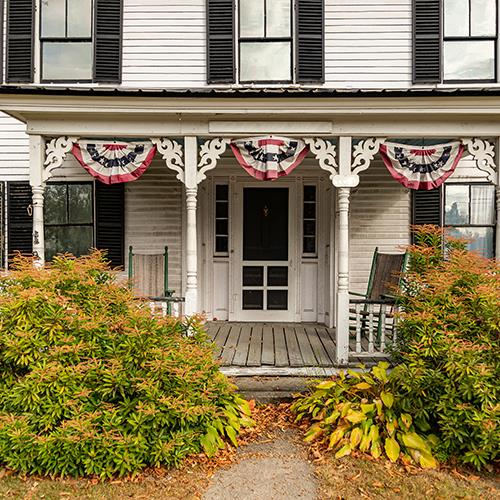
Kennebunkport, Maine (Captains Collection)
The mansions of the Captains Collection are among the oldest in Kennebunkport's historic district. These stately homes have passed through generations of Kennebunkport's seafaring families, and have been reunited as a luxury boutique experience that captures the history and spirit of the iconic Maine seaport. Many of the buildings here are from the late 18th and early 19th century, when Kennebunkport was at its height as a shipping and shipbuilding center. The district was added to the National Register of Historic Places on May 6, 1976. The oldest houses in the district date to the 1750s and 1760s, including most notably the Lord Mansion at 20 Summer Street. The northern portion of Summer Street is lined with houses built primarily in the first half of the 19th century for ship captains. The most elaborate and eye-catching of these is the so-called "Wedding Cake House", built in 1826.
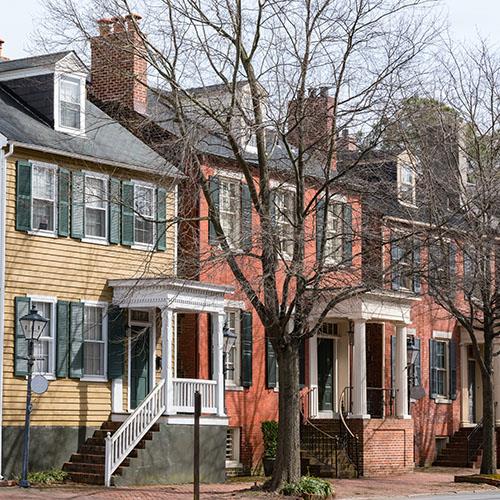
Portsmouth, New Hampshire (Wentworth-Coolidge Mansion)
The historic house, Wentworth-Coolidge Mansion, was built for colonial governor Benning Wentworth. Built in the mid-1700s, the mansion sits adjacent to the banks of Little harbor, a stunning backdrop for the charming home. The mansion is a 40-room dwelling with history and charm, that is historically important as the last standing residence of a royal governor. After serving as the primary home to governor Wentworth, it was purchased in the 1800s by J. Templamann Coolidge.
The mansion has been preserved to maintain the efficacy of its original architecture, furnishings, and decor. The historical society that maintains the mansion has ongoing garden and furniture restoration projects as well as sustained maintenance and beautification projects. The mansion is open for guided tours that offer a glimmer into how our forefathers lived.